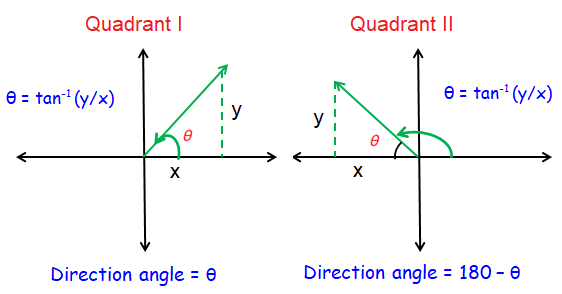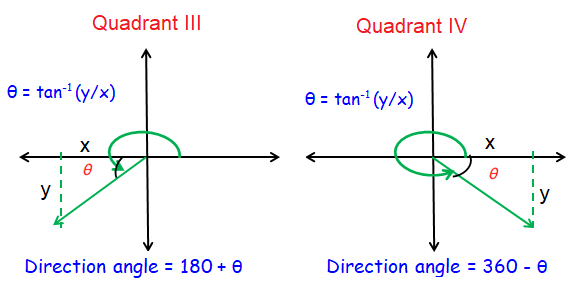FINDING DIRECTION ANGLE OF A VECTOR
Subscribe to our ▶️ YouTube channel 🔴 for the latest videos, updates, and tips.
The direction angle θ of a vector v is the angle formed from the x-axis counterclockwise to the ray along which v lies.


Given the initial and terminal points, find the following information for each vector: Component form, direction angle.
Problem 1 :
Solution:
Component form:
(C1, C2) = (1, -9) and (D1, D2) = (2, 1)
V = <D1 - C1, D2 - C2>
V = <(2 - 1), (1 + 9)>
V = < 1, 10 >
Direction angle:
We know that (1, 10) lies in quadrant I. Thus, the direction of the given vector is
θ = α
θ = 84.29°
Problem 2 :
Solution:
Component form:
(C1, C2) = (9, -6) and (D1, D2) = (4, -7)
V = <D1 - C1, D2 - C2>
V = <(4 - 9), (-7 + 6)>
V = < -5, -1 >
Direction angle:
We know that (-5, -1) lies in quadrant III. Thus, the direction of the given vector is
θ = α + 180°
θ = 11.31° + 180°
θ = 191.31°
Problem 3 :
Solution:
Component form:
(P1, P2) = (-2, 1) and (Q1, Q2) = (-1, 3)
V = <Q1 - P1, Q2 - P2>
V = <(-1 + 2), (3 - 1)>
V = < 1, 2 >
Magnitude:
We know that (1, 2) lies in quadrant I. Thus, the direction of the given vector is
θ = α
θ = 63.43°
Problem 4 :
Solution:
Component form:
(A1, A2) = (-6, -1) and (B1, B2) = (-5, 10)
V = <B1 - A1, B2 - A2>
V = <(-5 + 6), (10 + 1)>
V = < 1, 11 >
Magnitude:
We know that (1, 11) lies in quadrant I. Thus, the direction of the given vector is
θ = α
θ = 84.81°
Problem 5 :
Solution:
Component form:
(R1, R2) = (-1, -7) and (S1, S2) = (7, -1)
V = <S1 - R1, S2 - R2>
V = <(7 + 1), (-1 + 7)>
V = < 8, 6 >
Magnitude:
We know that (8, 6) lies in quadrant I. Thus, the direction of the given vector is
θ = α
θ = 36.87°
Subscribe to our ▶️ YouTube channel 🔴 for the latest videos, updates, and tips.
Recent Articles
-
Finding Range of Values Inequality Problems
May 21, 24 08:51 PM
Finding Range of Values Inequality Problems -
Solving Two Step Inequality Word Problems
May 21, 24 08:51 AM
Solving Two Step Inequality Word Problems -
Exponential Function Context and Data Modeling
May 20, 24 10:45 PM
Exponential Function Context and Data Modeling